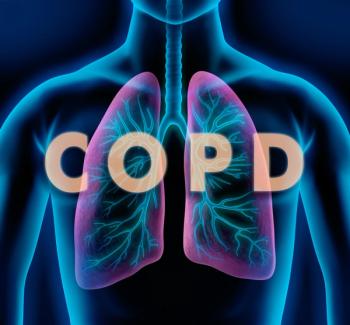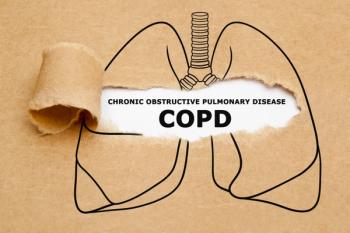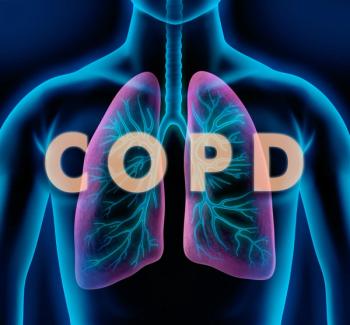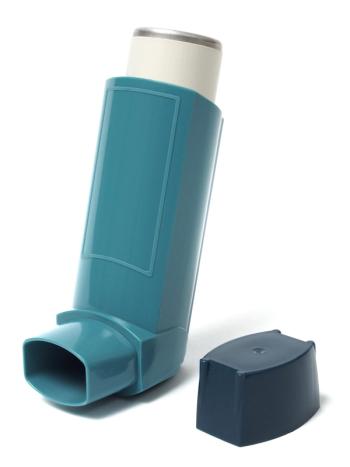
COPD
Latest News

Social frailty in patients with acute exacerbations of chronic obstructive pulmonary disease (COPD) does not directly impact anxiety or depression but influences these conditions indirectly through social support.
Latest Videos

CME Content
More News

Chinese adults with a poor socioeconomic status are at a higher risk of developing chronic obstructive pulmonary disease (COPD).

Psoriasis is not an independent risk factor for developing chronic obstructive pulmonary disease (COPD), according to a new study.

Patients with intellectual disabilities experience inconsistent chronic obstructive pulmonary disease (COPD) consultations and higher rates of antibiotic prescriptions for asthma, highlighting the need for improved and tailored primary care management.

Chronic obstructive pulmonary disease (COPD) significantly heightens the risk of mortality and hospitalization in patients with heart failure with preserved ejection fraction (HFpEF).

A Danish study found that living in cities with fewer than 50,000 residents and in newer, owned, and less dense homes is associated with a lower risk of developing chronic obstructive pulmonary disease (COPD).

Insurers continue to raise consumer costs despite covering fewer drugs and having more drug coverage restrictions; the Biden Administration is investing hundreds of millions of dollars to train geriatricians; the Federal Trade Commission has opened an investigation into Teva Pharmaceuticals after the company refused to take down patents for its asthma and chronic obstructive pulmonary disease inhalers.

Based on the 2024 State of the Air report, Munaf Siyamwala, MD, of Centerpoint Medical Center, noted that patients with COPD need personalized action plans to manage flare-ups exacerbated by poor air quality and extreme weather conditions.

Munaf Siyamwala, MD, of Centerpoint Medical Center, explained that summertime heatwaves and increased pollution significantly exacerbate symptoms for patients with chronic obstructive pulmonary disease (COPD).

Today, the FDA approved ensifentrine (Ohtuvayre; Verona Pharma) for the maintenance treatment of moderate to severe chronic obstructive pulmonary disease (COPD) based on the successful phase 3 ENHANCE trials.

Misuse of soft mist inhalers (SMIs) is common among patients with chronic obstructive pulmonary disease (COPD), particularly those with low education levels, higher symptom scores, and a shorter disease duration.

Surya Bhatt, MD, MSPH, of the University of Alabama at Birmingham, explained the phase 3 BOREAS and NOTUS trials demonstrated comparable safety profiles for dupilumab in treating patients with chronic obstructive pulmonary disease (COPD).

Surya Bhatt, MD, MSPH, of the University of Alabama at Birmingham, discussed the challenges of diagnosing chronic obstructive pulmonary disease (COPD) with type 2 inflammation, as well as the promising efficacy of dupilumab in treating this condition.

Two abstracts presented at the American Thoracic Society 2024 International Conference analyzed the phase 3 LIBERTY COPD BOREAS trial, finding that dupilumab improves pre- and post-bronchodilator lung function measures in patients with chronic obstructive pulmonary disease (COPD) and type 2 (T2) inflammation.

Patients with chronic obstructive pulmonary disease (COPD) and/or preserved ratio impaired spirometry (PRISm) have an increased risk of all-cause and cause-specific mortality, highlighting the need for better understanding of these conditions through increased spirometry data collection.

Italian patients with chronic obstructive pulmonary disease (COPD) face a significantly increased risk of severe cardiovascular events.

There is an extremely low rate of chronic obstructive pulmonary disease (COPD) diagnoses in Japan, particularly among patients with airflow obstruction, despite regular respiratory function tests.

Older patients with chronic obstructive pulmonary disease (COPD) and anxiety exhibited exacerbated symptoms, increased comorbidities, and frequent acute exacerbations of COPD (AECOPD), emphasizing the need for routine psychiatric screening in COPD management.

Vitamin D supplementation may decrease in-hospital and intensive care unit (ICU) mortality in patients with chronic obstructive pulmonary disease (COPD), a study found.

Patients with chronic obstructive pulmonary disease (COPD) and muscle loss phenotype (MLP) have an elevated risk of all-cause or COPD-related mortality.

Study findings demonstrate the pivotal role of patient-reported outcomes in identifying frailty among individuals experiencing acute exacerbations of chronic obstructive pulmonary disease (COPD).

A longtime respiratory therapist calls for reform of Medicare Advantage in light of denials of coverage for patients who need non-invasive ventilation.

Decreased body mass index (BMI) in patients with chronic obstructive pulmonary disease (COPD) was linked to a higher risk of severe exacerbations and all-cause mortality, emphasizing the importance of monitoring BMI for managing COPD and predicting outcomes.

Medication nonadherence among patients with chronic obstructive pulmonary disease (COPD) is associated with increasing COPD symptoms, hospitalizations, morbidity, mortality, and health care expenditures.

Dose-Escalation, Low-Dose Regimens May Improve Roflumilast Treatment Adherence in Patients With COPD
This study suggests that dose-escalation or low-dose regimens for roflumilast treatment in patients with chronic obstructive pulmonary disease (COPD) may improve adherence.

Reducing or quitting smoking significantly lowered the risk of lung cancer in patients with chronic obstructive pulmonary disease (COPD) who smoked less than 30 pack-years in a recent study.















































